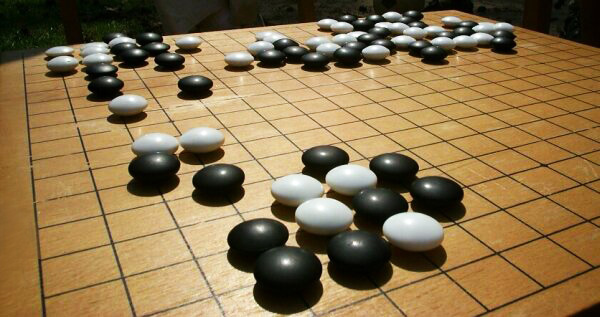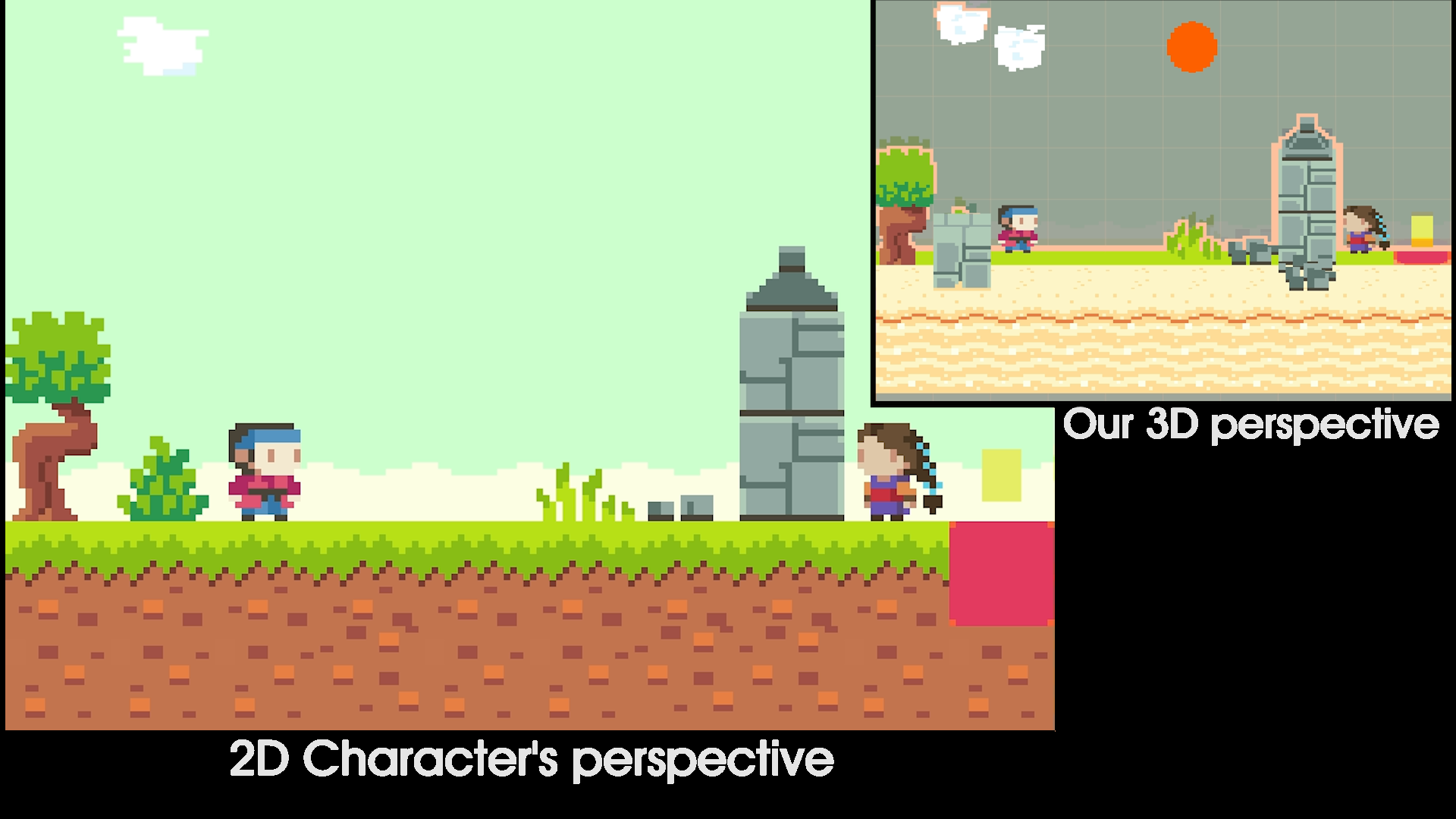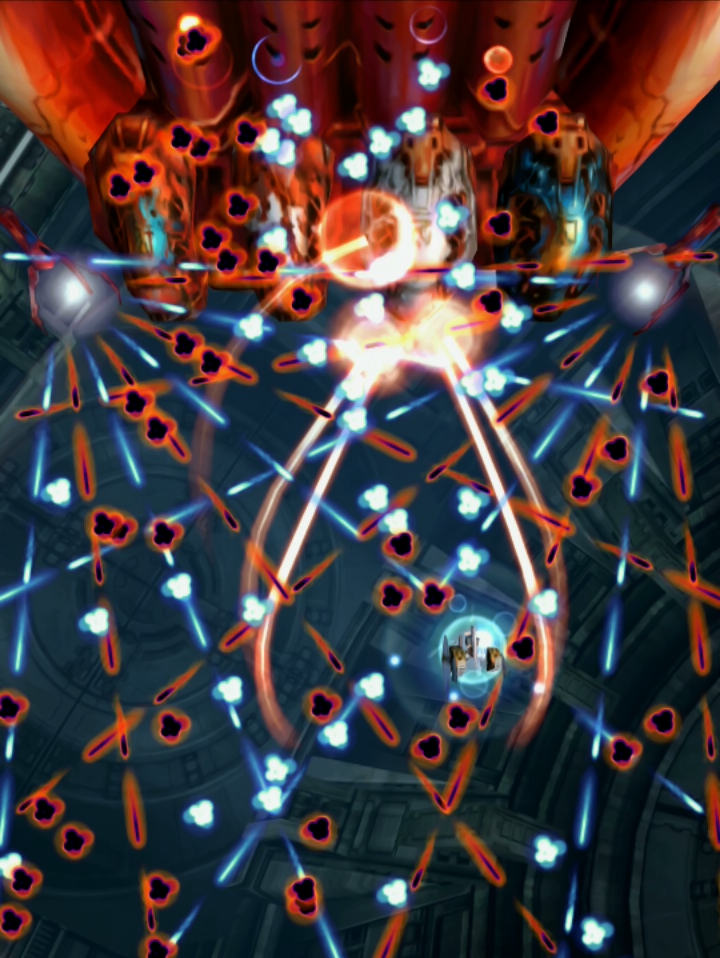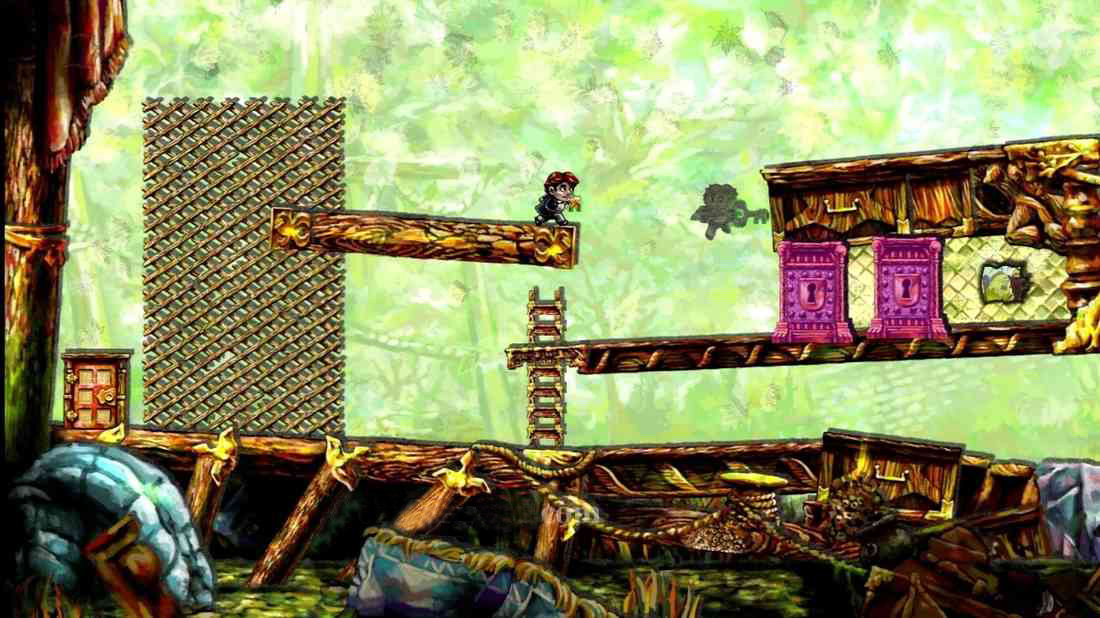
There are some games that are so simple, so pure, so fundamental that they feel like they were discovered, not invented. Go is a perfect example. Probably Tetris.
If I were to get really good at a game, I feel like such games would be more worthy of my time. It’s part of my game design philosophy to try and make games that are discovered, not invented.
When I started working on Miegakure, I had experimented a little bit with making higher-dimensional games and so I knew that the player would be looking along three vectors out of four (these vectors could be oriented any which way in 4D). Why did I chose to let the players see only along three dimensions (taking a 3D slice), and not project the entire four dimensions down to three, then to two for the screen?
First of all, I wanted the 4D world to feel like an extension of the 3D world we live in. What if our world actually had four dimension, but we didn’t know it? I love this idea of a mysterious fourth dimension, rumored, but never seen (that’s true in the real world too!). And as a player you are the only person you know that is capable of reaching it.
Second, if you use a projection a lot of objects are going to overlap on the screen, objects that you can’t actually touch because they are too far away. You could try to solve this problem by coloring objects differently based on where they are along the fourth dimension, but this is unnecessarily difficult to visually parse.
In retrospect, one thing that makes Miegakure special as compared to the few other 4D visualizations that exist is that it lets you touch the 4D objects as if they were real objects, and create entire 4D generalization of our world. This is something that is much harder to do using projections, which is the usual way of representing 4D objects, such as this more commonly seen, confusing-looking, projection of a Tesseract (the 4D equivalent of a cube).
Then there was the question, how should the player be allowed to move along the fourth, perpendicular vector? The obvious way would be to have the player press another couple of buttons to move up or down the 4D.
 It quickly became clear that you don’t want the player to move blindly along the fourth direction; you want vision and movement to be coupled: if you could move without being able to see where you are going, you would bump into invisible objects, and the whole world would change at each step (In the 2D/3D version of the game shown on the right and in this trailer, if you could side-step the world you see would change at each step).
It quickly became clear that you don’t want the player to move blindly along the fourth direction; you want vision and movement to be coupled: if you could move without being able to see where you are going, you would bump into invisible objects, and the whole world would change at each step (In the 2D/3D version of the game shown on the right and in this trailer, if you could side-step the world you see would change at each step).
So the idea of swapping a dimension for the fourth one came about. Inspired by Ikaruga (which is a beautiful shooter where all the complexity is derived only from the ability to switch colors by pressing one button), the simplest thing you can do is to have one button that swaps a dimension for the fourth one back and forth.
I loved the idea that the game plays like a regular platformer, except for this one special button that you press once in a while. Braid is also this way.
If you are only allowed to move along three dimensions, but you can pick which ones they are, then you can move anywhere in 4D. The following question remains: which direction will be swapped for the fourth one? If you name the three dimensions X,Y,Z,W, and decide that gravity will point down Z, then you don’t want to swap Z out, because it would look very confusing, and pressing the jump button should probably always move you in Z. So you’re left with swapping either X or Y. If doesn’t really matter which one we pick, in my case it’s Y. For simplicity X is left untouched. It would not be interesting enough to let players swap in the X direction to justify adding that ability. It also means that levels can be made harder or easier by simply rotating them 90 degrees in the XY plane (i.e. swapping X and Y)!
It turns out that a swap can be implemented as a 90 degree rotation, which can be interpolated smoothly (this is what is happening when the world looks like it is deforming).
As you can see, from first principles there was only one way to design Miegakure, and even though I was especially lucky in this case, that was very much something that I was trying to do. The rest was just exploration of this rule set.
But the next problem was: how do you make it so that the interactions are meaningful? 4D space is exponentially harder to fill with meaningful stuff. It takes 102=100 data points to fill a 10×10 grid, 103=1000 data points to fill a 10x10x10 grid, and 104=10000 data points to fill a 10x10x10x10 grid! This means that even if we take a small region of 4D space (10 units in each direction), we need a huge number of things to fill it with.
We want the number of objects to keep track of to be small to help the player hold them in their head. This essentially means that we want our “base” (the number that is raised to the power 4) to be small. This is how building the game out of 4D tiles, some of them pushable, with small levels (4x4x7x4 for example) came about. (Note that other, more detailed objects can always be placed on the tiles).
I think I may have been partly inspired by this puzzle from Braid (probably my favorite in the game!). The entire puzzle can fit on the screen; it’s just two doors and a key. It is extremely compressed. Everything extraneous to the puzzle itself has been removed. But it is still interesting and difficult to solve. All the difficulty is in the understanding of the systems at play, such that when you understand them properly the puzzle becomes trivial. (A video of it, spoilers!).
Because the number of objects to keep track of is small, it’s possible for the player to hold an entire level in their head. This is very important to me, because that means they are truly thinking in 4D, as opposed to looking at a bunch of 3D spaces one at a time.
At this point I could vaguely picture how to walk through walls using the fourth dimension in my head. I knew that since two dimensions are always visible an entire plane would stay the same after rotating, and therefore objects on this plane would be reference points, and that they would help the players orient themselves.
So I didn’t really know what the game would look like! I especially could not picture how the transition between the two states would look like. But I programmed it and found out and I was the first person to discover how to play the game.









Hi, do you have any plans regarding what you will do with your 4D engine after Miegakure is released?
It will be used on at least one other project.
I relate very much to your “discovered, not invented” approach to game creation. I think a lot in these terms when it comes to music composition or even popular media, actually. I believe that at this moment there “exist” yet-unrealized concepts that could become sensationally popular if somebody were to just stumble upon them. This also what attracts me to mathematics, at least fundamentally.
I don’t entirely believe Miegakure fits into this category from a pure design perspective, the same way something like Chess or Go do – but your solution to the problem of navigating 4D space in the context of the puzzle game you wanted to make certainly resembles this kind of “divine” insight. Otherwise you may have very well just had a parallel-worlds game, even if the 4D environment was accurately defined and represented.
The one (modern) game I consider truly “discovered” in the sense that it strikes me as utterly timeless and universal is Minecraft. I credit Notch with having the foresight and ingenuity to recognize before anyone else how the idea could be synergized of a few preexisting elements, but I don’t attribute the idea to him, or to anyone really. I don’t even think he attributes the idea to himself! More affecting is the fact that concepts like these sit dormant for generations, waiting for the right people or technologies to make them possible.
If it’s of some reassurance, Miegakure is one of maybe three or four games I know of being released at any point in the future that I still care about, and await expectantly. I very much hope it gets the recognition and acclaim it deserves.
I’m writing a new unique computer language and I subscribe to this whole ‘discovery’ philosophy as well. I’m finding that I am discovering the way to implement features which are a natural extension out of the approach that I am taking. It is always exciting to discover how to implement a feature that can only be done really one way as an extension out of the few initial defining rules that I have devised for this new language. It is quite often an unexpected surprise what the solution is. For example I discovered that putting the false before the path was the way to implement a true not path as a way to provide the ‘but only if not’ feature I wanted. This whole process is like that of finding the thing that is hidden in a block of wood as I have sometimes heard it described by a sculptor. If you define a few initial rules and see how it plays out there are quite often interesting discoveries in store.
That “discovered not invented” philosophy is quite elegant. You may also enjoy this article: http://www.gamasutra.com/blogs/TynanSylvester/20130311/188256/The_Design_Landscape.php
Looking forward to what else you discover in the 4th dimension! Your trailer, btw, helped me visualize the fourth dimension more than any other explanation, so thanks for that!
That quality of feeling discovered vs. invented is true of some art, especially music, so I wonder if there is a mathematical component to it? Perhaps this sensation is purely a response in our brain to certain stimulus patterns? Yet this perception/sensation is not limited to non-verbal or mathematically based works, either. I get that same feeling of agelessness from Theodore Sturgeon’s perfect short story, Slow Sculpture, it has a intense quality of self-containment, as though Sturgeon excavated it as a complete object rather than sat at a desk and wrote it. There are novels, sculptures, buildings, poems that also elicit this feeling, but it is certainly not many of them, and I suppose it could be argued that mathematics is hiding inside each of these in their proportions, rhythms, patterns. Very much looking forward to this game.
I like how you simplified the swap to Y it made my concept of how the game works seem easier. Will Megikure make it into early access? I’ve read so much I am ready to play it already! 🙂
The relationship between invention and discovery is surely dialectical.